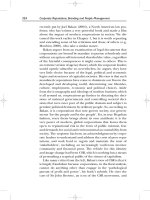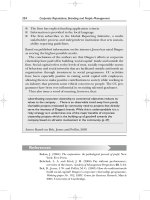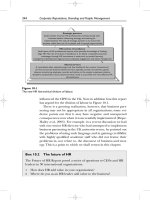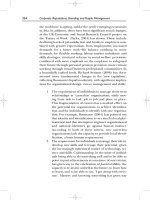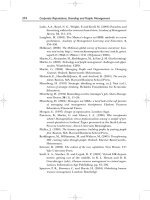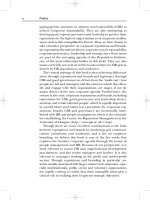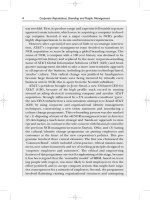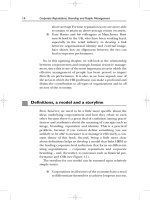Tài liệu Corporate Reputations, Branding and People Management 18 doc
Bạn đang xem bản rút gọn của tài liệu. Xem và tải ngay bản đầy đủ của tài liệu tại đây (140.36 KB, 10 trang )
154 Corporate Reputations, Branding and People Management
efforts with the ‘business’ managers to build high levels of employee
engagement and a strong employer brand. Such has been their contribu-
tion to the creation of the external brand image since 1997 and the devel-
opment of a strong internal identity, that they won a prestigious HR
Excellence award in 2001 for the company with the most innovative HR
practices.
The key driver for HR’s contribution to the establishment of such a
corporate reputation has been the need to recruit and retain talented
people, particularly the highly paid investment fund managers who are
at the core of the business and acknowledged to be the most important
competitive differentiator between investment houses. These people are
the equivalent of the stars in Premier League soccer or men and
women’s professional tennis and can earn salaries to match. Recruiting,
engaging and retaining these 150 ‘stars’, and the 500 or more people
that support them, has been a critical issue, especially since Standard
Life is committed to its Edinburgh base, outside of the main labour mar-
ket in London. Sitting alongside this ‘talent management’ driver has
been the desire of the company to create a more ‘professional’, team-
based culture, based on ‘adult’ relationships and high levels of trust,
instead of the previously hierarchical culture which they inherited from
their mutual assurance heritage. So, for example, the previous 20-graded
jobs structure has been eliminated, as has payment for overtime and
detailed job descriptions and evaluations. These have been replaced
with an output and high trust regime in which there is very little close
monitoring of work but individualized pay, in which the variable pay elem-
ent ranges from 15% of base salary for junior administrative staff to
200% for the investment fund managers.
The HR team has worked with business colleagues in investment and
marketing since 1997 to create a strong ‘internal’ or ‘employer’ brand,
which is treated as the key to matching client experiences and expect-
ations with the company’s promotional and advertising strategy and its
external image. This began with focus group interviews with customers
on determining the external brand values, which were fed back to
employees in numerous workshops to help them understand how clients
saw the organization, how they wanted to see it and what employees
would need to do differently to support the brand. Early on in this
process, they realized that achieving this aim would require a heavy invest-
ment in promoting ‘engagement’, which they defined in terms of loyalty
and psychological commitment to the company. Following some early
Chapter 4 The quality of individual employment relationships 155
investigative work, they commissioned the Gallup organization to con-
duct an investigation into the levels of engagement amongst employees.
A survey tool called Q12 was amended by the HR team to include eight of
their own questions, which subsequently became known as Q20 internally
and has been the principal means of measuring progress in employee
engagement since 1998. This measure has the added advantage of allow-
ing the company to benchmark its employees against other organizations
in financial services and against similar companies worldwide. Since the
first survey Standard Life have shown a steady improvement in those
employees defined as ‘actively engaged’ from 12% in December 1999 to
33% in February 2003, with those defined as ‘actively disengaged’ declin-
ing from 14% to 7% over the same period. According to Gallup external
benchmarking figures for the financial services industry, this has moved
Standard Life Investments from around the 50 percentile to the top
quartile of companies in terms of employee engagement. In addition, the
company reduced turnover levels from 12% in 1999 to 5% in 2002, and
calculated they have saved £0.5 million.
Senior HR staff saw these measurements as a critical element in help-
ing them make their case for continued inclusion in the corporate
reputation process with business managers who are used to financial
measurement. However, these measures are only the starting point in the
conversation about how to develop further the team-based culture and
individuals, all of whom undergo a ‘strength-finder’ career development
review and a 360 degree appraisal. HR staff stressed the importance of
integrating the internal and external image of the organization in these
interviews and the role of continuous communication in developing a
positive corporate reputation. They also stressed the importance of senior
management involvement in this process, with Sandy Crombie, the head
of Standard Life Investments in 1998 and now CEO of the main board of
Standard Life, taking an active role in the external and internal brand-
building process.
Conclusions
To bring this chapter to a conclusion, we have tried to set out a
necessarily more complex view of what it takes to connect people
to their organizations, hopefully in a readable way. This is best
156 Corporate Reputations, Branding and People Management
summarized by the processes and formulas in Figure 4.1. In our
view, organizations that really want to understand and manage
the quality of individual employment relations to create greater
organizational identification and positive outcomes such as cus-
tomer loyalty, positive reputations and brands need to adopt a
more evidence-based approach to HR (Pfeffer, 2005). This evi-
dence base may need to go beyond the current fashion for
engagement surveys, which are a rather blunt, but nevertheless
useful, instrument for tapping emotions, understanding and
behaviours in employment. For example, in our case, Standard
Life Investments have, wisely in our opinion, added additional
questions to the standard engagement survey. However, they,
like many organizations, may not have gone far enough.
Our main recommendation from this chapter is that organiza-
tions wanting to know about their employees and wanting to
engage in more sophisticated HR practices, such as segmentation
and high performance work practices (see Chapter 5), need to
understand the nature and variation of psychological contracts in
their organizations, the key individual–organizational linkages of
identification, internalization, psychological ownership and con-
tinuance commitment, and the levels of engagement behaviours
claimed by employees in their day-to-day work. This need not
involve enormous questionnaires that employees are reluctant to
complete because of being over-surveyed, but will necessarily be
longer than the typical, 12-question engagement survey. Good
examples of standard questionnaires used to identify the state of
psychological contracts are contained in the book by Conway and
Briner (2005). Besides, in our experience, so long as employees
find the questionnaires interesting and relevant in giving them a
voice on matters that are important to them, they will complete
longer and more in-depth surveys on a fairly frequent basis. Now,
however, we move onto the core HR processes that help drive
these employee relationships.
References
Arthur, M. B., Inkson, K. and Pringle, J. K. (1999) The new careers: indi-
vidual action and economic change. London: Sage.
Ashforth, B. E. and Mael, F. (1989) Social identity theory and the
organization, Academy of Management Review, 14, 20–39.
Barrow, S. and Mosley, R. (2005) The Employer Brand
®
: bringing the best
of brand management to people at work. London: Wiley.
Bhattacharya, R., Devinney, T. and Pilluta, M. M. (1998) A formal
model of trust based on outcomes, Academy of Management Review,
23, 459–472.
Brown, A. D. (1997) Narcissism, identity and legitimacy, Academy of
Management Review, 22, 643–686.
Cappelli, P. (1999) The New Deal at work: managing the market-driven
workforce. Boston, MA: Harvard Business School Press.
CIPD (2003a) Managing the psychological contract. Factsheet, May.
Wimbledon: Chartered Institute of Personnel and Development.
CIPD (2003b) Living to work. CIPD Survey, October. Wimbledon:
Chartered Institute of Personnel and Development.
CIPD (2005) Employee well-being and the psychological contract.
Wimbledon: Chartered Institute of Personnel and Development.
Clegg, S., Kornberger, M. and Pitsis, T. (2005) Management and organ-
izations: an introduction to theory and practice. London: Sage.
Conway, N. and Briner, R. B. (2002) A daily diary study of affective
responses to psychological contract breach and exceeded prom-
ises, Journal of Organizational Behaviour, 21, 25–42.
Conway, N. and Briner, R. B. (2005) Understanding psychological contracts
at work: a critical evaluation of theory and research. Oxford: Oxford
University Press.
Davenport, T. H. (2005) Thinking for a living: how to get better performance
and results from knowledge workers. Boston, MA: Harvard Business
School Press.
Dutton, J. E., Dukerich, J. M. and Harquail, C. V. (1994) Organizational
images and member identification, Administrative Science Quarterly,
39, 57–88.
Florida, R. (2002) The rise of the creative class. New York: HarperCollins.
Florida, R. (2005) The flight of the creative class. New York: HarperCollins.
Goffee, R. and Jones, G. (2005) Individual and collective leadership
in the boardroom: why feedback is vital even at the top,
Ivey Business Journal Online, September/October. http://
www.iveybusinessjournal.com/article.asp?intArticle_idϭ581
(28 February 2006).
Grey, C. (2005) A very short, fairly interesting and reasonably cheap book about
studying organizations. London: Sage.
Guest, D. and Conway, N. (2002) Communicating the psychological
contract: an employer perspective, Human Resource Management
Journal, 12 (2), 22–38.
Chapter 4 The quality of individual employment relationships 157
Harter, J. M., Schmidt, F. and Hayes, T. L. (2002) Business unit level
relationships between employee satisfaction/engagement and
business outcomes: a meta-analysis, Journal of Applied Psychology,
87, 268–279.
Hatch, M. J. and Schultz, M. (2004) Organizational identity: a reader.
Oxford: Oxford University Press.
Herriot, P. (2001) The employment relationship: a psychological perspective.
Hove: Routledge.
Herriot, P., Manning, W. E. G. and Kidd, J. M. (1997) The content
of the psychological contract, British Journal of Management, 8,
151–162.
Huselid, M. A., Becker, B. E. and Beatty, R. W. (2005) The workforce score-
card: managing human capital to execute strategy. Boston, MA:
Harvard Business School Press.
Mael, F. A. and Ashforth, B. E. (1992) Alumni and their alma mater:
a partial test of the reformulated model of organizational iden-
tification, Journal of Occupation Behaviour, 13, 103–123.
Martin, G., Staines, H. and Pate, J. (1998) The New Psychological
Contract: exploring the relationship between job security and
career development, Human Resource Management Journal, 6 (3),
20–40.
Martin, G., Pate, J. M., Beaumont, P. B. and Murdoch, A. (2003) The
uncertain road to partnership: industrial relations in the UK
North Sea drilling industry, Employee Relations, 25 (6), 594–612.
Meyer, J. P. and Allen, N. J. (1991) A three-component conceptualiza-
tion of organizational commitment, Human Resource Management
Review, 1 (1), 61–79.
Pate, J., Martin, G. and McGoldrick, J. (2003) The psychological con-
tract, trust and violation: a conceptual model and some case
study evidence, Employee Relations, 25, 557–573.
Pate, J. M., Martin, G. and Staines, H. (2000) The new psychological
contract, cynicism and organizational change: a theoretical frame-
work and case study evidence, Journal of Strategic Change, 9 (1),
481–493.
Pfeffer, J. (2001) Fighting the war for talent is dangerous to your orga-
nization’s health, Organizational Dynamics, 29 (4), 248–259.
Pfeffer, J. (2005) Creating a performance culture. Presentation at
University of Strathclyde, 23 September.
Pierce, J. L, Kostova, T. and Dirks, K. T. (2001) Towards a theory of psy-
chological ownership in organizations, Academy of Management
Review, 26 (2), 298–310.
Reade, C. (2001) Antecedents of organizational identification in
multinational corporations: fostering psychological attachment
158 Corporate Reputations, Branding and People Management
to the local subsidiary and the global organization, International
Journal of Human Resource Management, 12, 1269–1291.
Robinson, D., Perryman, S. and Hayday, S. (2004) The drivers of
employee engagement. IES Report no 408, Brighton: Institute of
Employment Studies.
Rousseau, D. (1995) Psychological contracts in organizations: understand-
ing written and unwritten agreements. Newbury Park, CA: Sage.
Rousseau, D. M. (2001) The idiosyncratic deal: flexibility versus fair-
ness, Organizational Dynamics, 29 (4), 260–273.
Scott, S. G. and Lane, V. R. (2000) A stakeholder approach to organiza-
tional identity, Academy of Management Review, 25, 43–62.
Sparrow, P. and Cooper, C. (2003) The employment relationship: key chal-
lenges for HR. Oxford: Butterworth–Heinemann.
Sutton, R. I. (2001) Weird ideas that work: 11
1
⁄2 ways to promote, manage
and sustain innovation. London: Allen Lane, Penguin Press.
Swailes, S. (2002) Organizational commitment: a critique of the con-
struct and its measures, International Journal of Management
Research, 4 (2), 155–178.
Thompson, J. A. and Bunderson, J. S. (2003) Violations of principle:
ideological currency in the psychological contract, Academy of
Management Review, 28 (4), 571–586.
Towers Perrin (2003) Working today: understanding what drives
employee engagement. />hrservices/webcache/towers/United_States/publications/
Reports/Talent_Report_2003/Talent_2003.pdf (18 February
2006).
Turnley, W.H. and Feldman, D. C. (1998) Psychological contract
violations during corporate restructuring, Human Resource
Management, 37 (1), 71–83.
Wright, P. M., Dunford, B. B. and Snell, S. A. (2001) Human resource
management and the resource based view of the firm, Journal of
Management, 27, 701–721.
Chapter 4 The quality of individual employment relationships 159
This page intentionally left blank
CHAPTER
Four lenses on HR
strategy and the
employment relationship
5
Introduction
In this chapter and the next one we discuss what the HR func-
tion can contribute to branding, reputations and performance
through its impact on the lived experience of employees and the
quality of their individual employment relationships. As we have
already pointed out, however, this is not a one-way process. Just
as HR can drive reputations, brands and performance, in turn,
these outcomes help attract and retain talented people, one of
the major challenges facing most organizations (see Figure 5.1).
What people on the inside think about organizational identity and
image is informed by how they think relevant outsiders see them,
for example from the views of professional colleagues, potential
employees, the financial press, customers, CSR ratings, environ-
mental activists and the public at large. So, employees’ views of
positive perceptions are likely to influence their willingness to
remain with the company; furthermore, talented people are
The connections between HR drivers, however, and these
other variables are not as clear-cut as many of the more pre-
scriptive HR texts would have you believe, nor as simple as
Figure 5.1 would imply. How HR fast-forwards into individual
employment relations and interpenetrates with corporate strat-
egy is a rather more complex process; it is not just a question of
aligning HR with the business strategy and pulling the right
levers to generate positive psychological contracts and engaged
employees. If life were so easy, there would be little point in
writing yet another ‘how to’ book on the subject, since the mar-
ket is awash with them. Most of these, researched and written
with varying degrees of sophistication, are of the ‘one-best-way’
variety, with a basic but compelling message (not always intended
but often read as such): search for best practices among ‘best-
in-class’ firms on a range of HR variables, benchmark yourself
against these firms and implement those practices that fit
your needs, sometimes in a ‘pick-’n-mix’ fashion. Some of these
works are naïve in the extreme; others are exceptionally good.
We would include in the good category Jeff Pfeffer’s (1998,
162 Corporate Reputations, Branding and People Management
Corporate
identity
Corporate
leadership
and vision
HR
competence
and
credibility
Communications
and employer
branding
Quality of
individual
employment
relations and
behaviours
Corporate
strategy
HR strategies and
talent
management
Figure 5.1
Linking HR and talent management to strategy and the quality of
individual employment relations.
attracted by high performing and reputable companies, one of
the reasons underlying an employer of choice strategy (see
Chapter 7).
2005) works, discussed later in this chapter, especially in provid-
ing ‘evidence-based’ practices and in simplifying and commu-
nicating complex realities.
The very idea of best practices, however, has been roundly crit-
icized by writers and practitioners who argue that ‘context mat-
ters’. This has resulted in another school of thought in strategic
HRM, which focuses on the ‘fit’ between bundles of practices and
organizational contexts. This ‘it-all-depends-on-the strategic-envi-
ronment’ approach is based on a few simple ideas. The first is
that HR has to address the key strategic drivers of an organiza-
tion, though these may vary according to competitive circum-
stances. The second is that there is no sustainable competitive
advantage in doing what everyone else is doing, especially if you
are one of the late-comers. The third is that there is little sense in
treating all employees the same, in terms of their added value to
an organization’s key strategic drivers, their abilities and what
they want from work. These are the messages of a number of
influential books and articles, including one by Huselid et al.
(2005), which we shall also examine in this chapter and when dis-
cussing segmentation approaches to people management and
HR in Chapter 6.
As important as the best practice/best fit debate is for our
understanding of HR, reputations and brands, under-girding it
is another level of analysis with even more profound conse-
quences for HR and its connections to outcomes, ethics and
change models. To paraphrase the title in the excellent stra-
tegic management book by Richard Whittington (2001), we really
should be asking the questions: ‘what is HR strategy and does it
really matter to reputation management and brand perform-
ance?’. The answers, according to Whittington, in his more
general discussion of business strategy, depend on what the
outcomes are/should be and how we should/do go about devising
and implementing such strategies (see also Legge, 2004, who also
adopted Whittington’s model to explain HRM).
Concerning the first of these questions on the outcomes of
strategy – the goals to which strategy is (or should be) directed –
we have to ask ourselves: are we trying to achieve a unitary goal
such as increased shareholder value, or are we looking to balance
this with other outcomes such as public good, good governance
and a socially and environmentally responsible reputation
Chapter 5 Four lenses on HR strategy and the employment relationship 163
